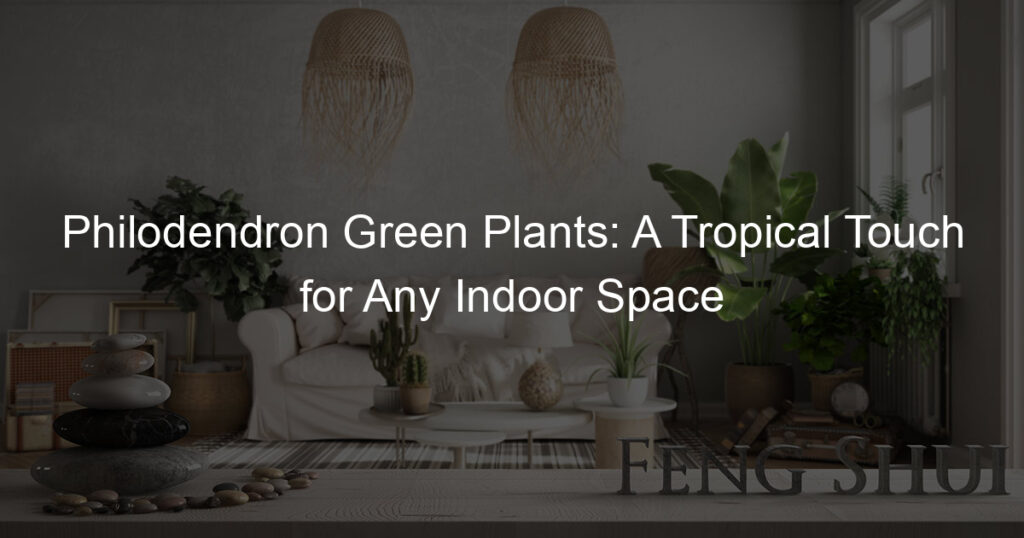Are you looking for a unique and lush way to add some tropical flair to your indoor space? Look no further than the beautiful and captivating Philodendron Green plants!
This species of plant is native to the tropical areas of South America, with stunning foliage that comes in a variety of colors, shapes, and heights. Not only can they be an eye-catching addition to any room in your home or office, but Philodendron Green plants are easy and low maintenance–plus they’re great at cleaning your air quality and providing calming vibes all at once!
Whether you’re just starting out as a Plant Parent or have been “Green Thumbing” for years–this blog post will provide all the information you need on growing these gorgeous Indoor Plants.
Is philodendron a good indoor plant?
Philodendron has become quite popular recently as an indoor plant. Not only does it require minimal maintenance and care, but it also looks good in any setting.
From the home to the office, it adds a natural flair to the atmosphere. It’s also a great choice for those with limited space because philodendrons are small and can easily fit on any shelf or tabletop. They come in various shapes and sizes, which offers plenty of options if you’d like to mix up your indoor plant look.
Perhaps best of all, they are very easy to care for and often thrive indoors over long periods of time with minimal effort. All-in-all, philodendron is an excellent choice for anyone looking for a low-maintenance indoor plant that stands out from the crowd.
Where should I place a philodendron in my house?
A philodendron is an ideal houseplant: it is low-maintenance, tolerant of a wide range of environmental conditions, and can survive low-light levels. To give your philodendron the happiest home possible, place it in an area with bright, indirect light; this could be a few feet away from a sunny window or in a brightly lit room that has no direct exposure to sunlight.
Additionally, make sure that it’s placed somewhere where there is adequate ventilation — you don’t want any drafts! Finally, like all houseplants, your philodendron needs occasional watering – but only when the top soil becomes dry. With these simple tips and tricks in mind, your philodendron will be happy and healthy in its new home.
Where is the best place to plant a philodendron?
For those looking to bring an exotic and tropical flair to their garden, a philodendron is an excellent choice for both its vibrant aesthetic and its hardiness in gardening conditions.
When selecting the spot of your philodendron’s new home, it should be noted that they prefer well-draining soils and partial sunlight or dappled shade. A good location to plant your philodendron is near windows or other areas of the home where it can take advantage of indirect light while taking care not to leave them exposed to direct sunlight too long to avoid burning its leaves.
Additionally, indoor humidifiers should be considered when planting indoors, keeping the area around the philodendron consistently moist so that it can thrive best.
Are philodendrons tropical plants?
Philodendrons are some of the most popular house plants but they can be surprisingly hard to classify. While they are often associated with tropical climates, technically not all philodendrons are tropical plants.
There are over 200 different species of philodendron and some species have adapted to a diverse range of weather conditions, making them able to survive in areas with more temperate climates.
However, these are usually vines or smaller shrub-like varieties and not the larger, leafier species that many people associate with indoor house plants. Regardless of their natural habitats, philodendrons remain one of the most gorgeous and easy-to-care-for houseplants, regardless if they originate from tropical or temperate environments.
How often do you water philodendrons?
Philodendrons are hardy plants that are easy to take care of, but their water needs depend on the season and whether the plant is indoors or outdoors. Generally speaking, you want to keep an eye on the soil under your philodendron and only add water when it’s dry – usually every 2-3 weeks will do in spring and summer when they’re actively growing.
If they’re kept inside, reduce this amount slightly. In autumn and winter months, water is just enough to keep the soil lightly moist; no more than once a week will suffice during these seasons.
As with most houseplants, take time to monitor your philodendron for signs of wilting or yellowing; if present, simply increase the frequency of watering accordingly. With minimal maintenance and attention, you can enjoy a healthy philodendron year-round!
Final Thoughts
From the elegant Ivy to the easygoing Heartleaf, the Philodendron family offers a range of choices for brightening up any indoor space. If you’re looking to add a tropical touch of natural beauty and air-purifying benefits to your home or office, Philodendron green plants can offer just that.
Not only do these hardy plants thrive in low-light environments and require minimal upkeep, but also they come in many varieties to choose from! With so much going for it, the Philodendron is an ideal way to liven up your interior space and bring more nature into your life.
So why not take advantage of their tropical essence today and give your living area an eye-catching upgrade? You won’t regret it!














